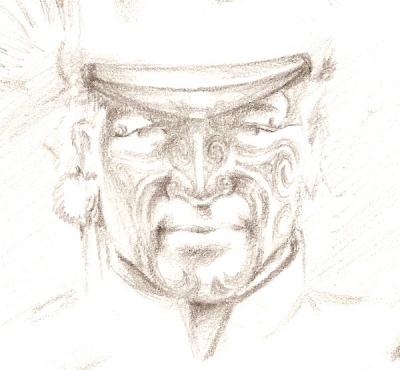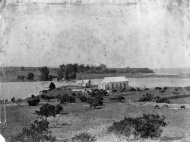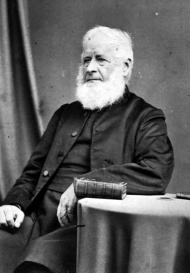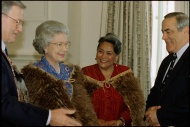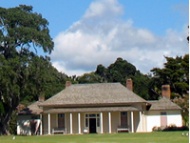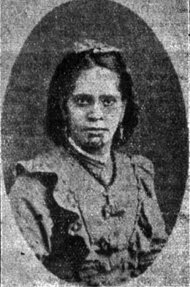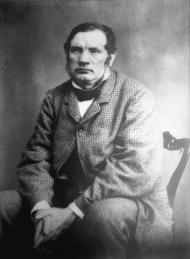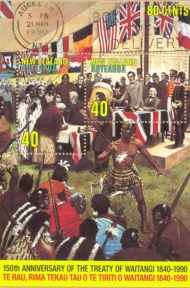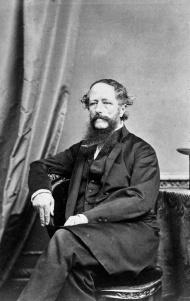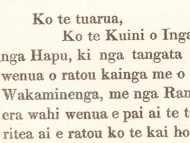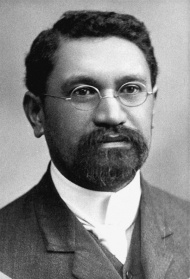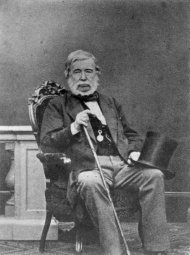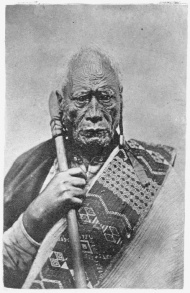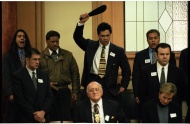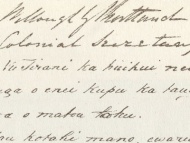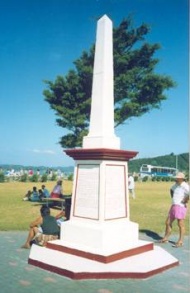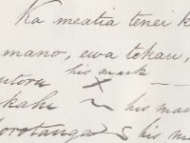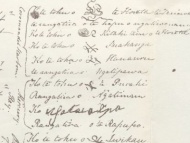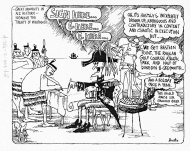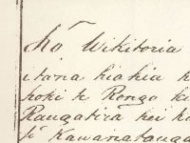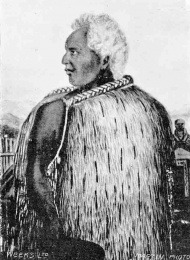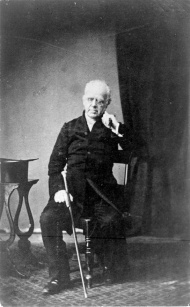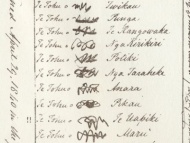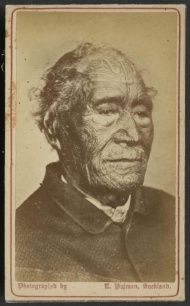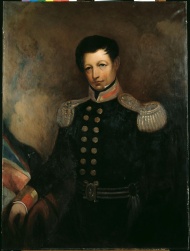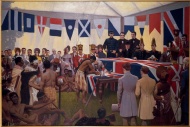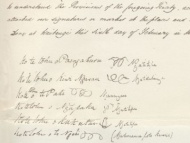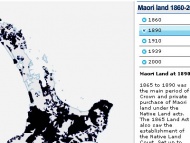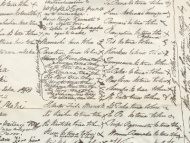Events In History
-
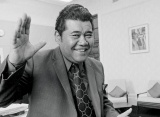 10 October 1975Waitangi Tribunal created
10 October 1975Waitangi Tribunal createdThe Labour government created the Tribunal to hear Māori claims of breaches of the Treaty of Waitangi. It has evolved ever since, adapting to the demands of claimants, government and public. Read more...
-
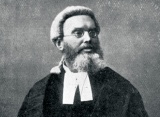 17 October 1877Chief Justice declares treaty 'worthless' and a 'simple nullity'
17 October 1877Chief Justice declares treaty 'worthless' and a 'simple nullity'Chief Justice Sir James Prendergast’s statements when delivering judgment in the case of Wi Parata v The Bishop of Wellington would influence decision-making on Treaty of Waitangi issues for decades. Read more...
-
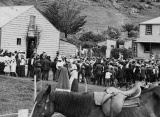 30 October 1865Native Land Court created
30 October 1865Native Land Court createdThe Native Land Court was one of the key products of the Native Lands Act 1865. It enabled the conversion of traditional communal landholdings into individual titles, making it much easier for Pākehā to purchase Māori land. Read more...
-
 11 March 1845The fall of Kororāreka
11 March 1845The fall of KororārekaAfter hundreds of Ngāpuhi fighters led by Kawiti and Hōne Heke attacked Kororāreka (Russell), most of its inhabitants were evacuated by sea. The flagstaff on nearby Maiki Hill was cut down for the fourth and last time. Read more...
-
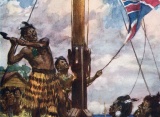 19 January 1845Hōne Heke cuts down the British flagstaff - again
19 January 1845Hōne Heke cuts down the British flagstaff - againThe first Māori to sign the Treaty of Waitangi, Ngāpuhi chief Hōne Heke Pōkai soon became disenchanted with the consequences of colonisation. Read more...
-
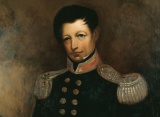 21 May 1840Hobson proclaims British sovereignty over New Zealand
21 May 1840Hobson proclaims British sovereignty over New ZealandLieutenant-Governor William Hobson proclaimed British sovereignty over all of New Zealand – the North Island on the basis of cession through the Treaty of Waitangi, and South and Stewart Islands by right of discovery. Read more...
-
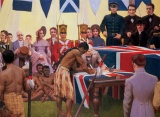 6 February 1840Treaty of Waitangi signed
6 February 1840Treaty of Waitangi signedMore than 40 Māori chiefs signed a treaty with the British Crown in the Bay of Islands. The Treaty of Waitangi remains controversial. Read more...
-
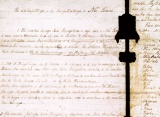 28 October 1835He Whakaputanga signed by northern chiefs
28 October 1835He Whakaputanga signed by northern chiefsThirty-four northern chiefs signed He Whakaputanga (a declaration of independence) at a hui called by the British Resident, James Busby. Read more...
Articles
Waitangi Day
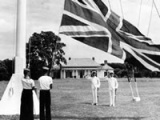
Every year on 6 February, New Zealand marks the signing of the Treaty of Waitangi in 1840. For most people, Waitangi Day is a holiday; for many, and especially for Māori, it is a time for reflecting on the Treaty and its place in modern New Zealand.
-
Page 3 – Waitangi Day 1940s-1950s
From the 1940s the Treaty and Waitangi began to find a place in the national consciousness. For most New Zealanders, they were of historical interest only.
The Treaty in practice
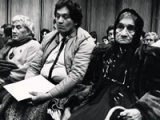
Amalgamating Māori into colonial settler society was a key part of British policy in New Zealand after 1840. Economic and social change, along with land-purchase programmes, were central to this process.
-
Page 2 – Slide to war
War raged in the North Island in the mid-19th century. The period from 1860, when conflict broke out in Taranaki, through to about 1872, is commonly called the New Zealand Wars
-
Page 3 – Obtaining land
How to obtain land for European settlement was always a key issue in New Zealand. With the wars of the 1860s, a new legal system backed up conquest as a means of gaining Māori
-
Page 4 – Shared issues and approaches
Prospects for Māori looked bleak at the beginning of the 20th century. A shared sense of grievance emerged, and new leaders paved the way for new approaches to the Crown.
-
Page 5 – Growing interest in the Treaty
The early 20th century saw new approaches to dealing with Māori grievances and a renewed interest in the Treaty of Waitangi as the nation's founding document.
-
Page 6 – The Treaty debated
Modern New Zealand has debated the Treaty of Waitangi as never before. Understanding, reconciliation, protest and confrontation have been part of this process.
-
Page 7 – The Ngāi Tahu claim
Ngāi Tahu signed a Deed of Settlement with the Crown in 1998. This completed almost 150 years of the tribe's struggle to have the Crown honour its obligations under the Treaty
-
Page 9 – Further information
A selection of further information on the Treaty in practice.
Treaty signatories and signing locations
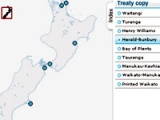
The Treaty of Waitangi was signed on nine separate sheets by more than 500 Māori. Find out more about the sheets, the signatories and the signing locations
-
Page 2 – Ngā tohu – treaty signatories
When complete, Ngā tohu – treaty signatories will include biographical information on every signatory of the Treaty of Waitangi who can be identified.
-
Page 3 – Ngā Wāhi – Treaty Signing Occasions
The Treaty of Waitangi was first signed on 6 February 1840.
-
Page 4 – Making the Treaty of Waitangi
New Zealand's founding document, the Treaty of Waitangi, was prepared over just a few days in February 1840. Several versions of the treaty were taken around the country for
-
Page 5 – Signing the treaty
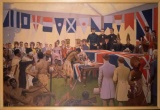
By the end of 1840 about 540 Māori, including 13 women, had signed the Treaty of Waitangi; all but 39 signed the Māori text. While some had clear expectations about what their
-
Page 6 – Preserving the documents
The Treaty of Waitangi is currently on display in the He Tohu exhibition at the National Library of New Zealand in Wellington. It has not always been so secure. Water, time and
-
Page 7 – Further information
Further information on the signing of the Treaty of Waitangi.
Read the Treaty
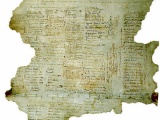
Transcript of the English version of the original Treaty of Waitangi document.
-
Page 2 – Māori text of Te Tiriti
Transcript of the Māori version of the original Treaty of Waitangi document.
-
Page 3 – Differences between the texts
The Treaty of Waitangi has two texts. The Maori version is not an exact translation of the English, and there are important differences.
-
Page 5 – Further information
Further information on the wording of the Treaty of Waitangi.
Treaty timeline
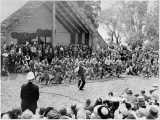
See some of the key events between 1800 and 1849 relating to the Treaty of Waitangi.
-
Page 2 – Treaty events 1850-99
See the key events between 1850 and 1899 relating to the Treaty of Waitangi.
-
Page 3 – Treaty events 1900-49
Discover some of the key events between 1900 and 1949 relating to the Treaty of Waitangi.
-
Page 4 – Treaty events since 1950
Learn about some of the key events from 1950 onwards relating to the Treaty of Waitangi.
-
Page 5 – Further information
Find out more about the Treaty.
Treaty biographies
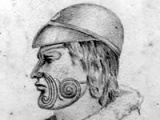
Information about some of the key people who have featured in the story of the Treaty of Waitangi
-
Page 2 – Further information
Discover more Treaty biographies
The Treaty in brief

The Treaty of Waitangi is New Zealand’s founding document. It takes its name from the place in the Bay of Islands where it was first signed, on 6 February 1840. The Treaty is an agreement, in Māori and English, that was made between the British Crown and about 540 Māori rangatira (chiefs).
-
Page 2 – Treaty FAQs

Answers to some common questions about the Treaty of Waitangi.
-
Page 3 – Further information
More information, in brief, on the Treaty of Waitangi.
Treaty of Waitangi

Activities to determine what students already know about the Treaty of Waitangi
- Page 1 - Treaty of WaitangiActivities to determine what students already know about the Treaty of Waitangi
Political and constitutional timeline
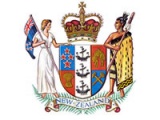
Pivotal political and constitutional events with links to further information
- Page 1 - Political and constitutional timelinePivotal political and constitutional events with links to further
A history of New Zealand 1769-1914
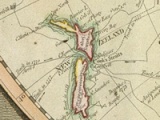
In the period between the first European landings and the First World War, Aotearoa New Zealand was transformed from an exclusively Māori world into one in which Pākehā dominated numerically, politically, socially and economically.
- Page 1 - History of New Zealand, 1769-1914 In the period between the first European landings and the First World War, Aotearoa New Zealand was transformed from an exclusively Māori world into one in which Pākehā
Network Waitangi Ōtautahi
Teaching te Tiriti o Waitangi
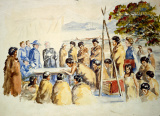
Te Tiriti/the Treaty has been variously described as a founding document, a sacred covenant and a fraud. It speaks through many voices, past and present. So, what are some ways to teach the history of this document and analyse its ongoing impacts?
- Page 1 - Teaching Te Tiriti o Waitangi Te Tiriti/the Treaty has been variously described as a founding document, a sacred covenant and a fraud. It speaks through many voices, past and present. So, what are some ways to
Stories in the land field trip
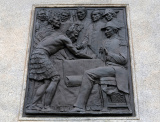
Field trips are a fantastic way for students and teachers to develop shared experiences outside of the classroom. This field trip – ‘Stories in the land’ – is facilitated by educator-historian Ricky Prebble and can be adapted for senior and junior students.
- Page 1 - Stories in the land field tripField trips are a fantastic way for students and teachers to develop shared experiences outside of the classroom. This field trip – ‘Stories in the land’ – is facilitated
History of the Governor-General
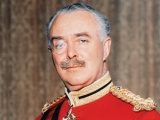
New Zealand has had a governor or (from 1917) a governor-general since 1840. The work of these men and women has reflected the constitutional and political history of New Zealand in many ways.
- Page 3 - Crown colony eraNew Zealand became a British colony in 1840, legitimised by the Treaty of Waitangi and Lieutenant-Governor William Hobson's 21 May declaration of
Māori King movement origins
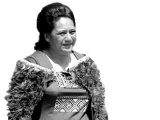
In May 2008 Māori gathered at Ngāruawāhia to celebrate the 150th anniversary of the formation of the Kīngitanga, or Māori King Movement. The current king, Te Arikinui Tūheitia Paki, was crowned in August 2006 following the death of his mother, Dame Te Atairangikaahu.
- Page 3 - The land issuePressure to sell land was a key factor in the creation of the Kīngitanga. Before European settlement Māori had no concept of selling land and few chiefs had the authority to
Māori King movement - 1860-94
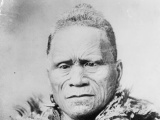
King Tāwhiao's reign was dominated by the Waikato War and the fallout from it.
- Page 4 - RaupatuUnder the terms of the New Zealand Settlements Act 1863 the government confiscated huge areas of Māori land in late
The 1940 Centennial

The centennial celebrations of 1940 marked a century of European effort and progress. Māori history and the centenary of the signing of the Treaty of Waitangi took a back seat.
- Page 5 - The Treaty of WaitangiDespite all the talk of the 'birth of a nation', the place of the Treaty of Waitangi or Māori in the centennial celebrations was less
Taming the frontier
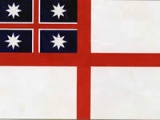
In 1832 James Busby was appointed as the official British Resident to New Zealand. After arriving in the Bay of Islands in May 1833 he took steps to tame what he saw as a chaotic frontier society.
-
Page 5 – A separate Crown colony
Protecting Māori, regulating land purchases, controlling the activities of settlers and dealing with the potential influx of migrants underpinned British policy in 1839. New
Links - Treaty of Waitangi
- Page 1 - Treaty of Waitangi linksLinks and further information about the Treaty of
Biographies
-
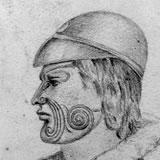 Heke Pōkai, Hōne Wiremu
Heke Pōkai, Hōne Wiremu
Ngāpuhi chief Hōne Heke was an influential northern Māori voice in favour of the Treaty of Waitangi. However, he later became a leading opponent of British rule in New Zealand.
Read more... -
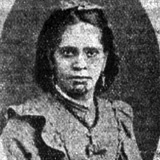 Kahutia, Riperata
Kahutia, Riperata
Riperata Kahutia became a well-known figure in the Poverty Bay region through her claims in the Native Land Court and the Poverty Bay Commission.
Read more... -
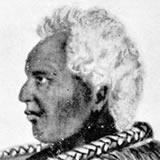 Kawiti, Te Ruki
Kawiti, Te Ruki
A notable Ngāpuhi chief and warrior and a skilled military tactician who reluctantly signed the Treaty of Waitangi in 1840.
Read more... -
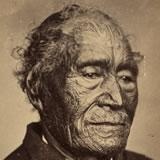 Nene, Tāmati Wāka
Nene, Tāmati Wāka
Renowned Ngāpuhi chief, Tāmati Wāka Nene, was an early friend of Pākehā. He was one of its most influential supporters in the debate at Waitangi over the Treaty and he was among the first to sign.
Read more... -
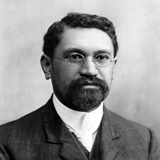 Ngāpua, Hōne Heke
Ngāpua, Hōne Heke
Hōne Heke Ngāpua was elected to Parliament in 1893 and represented the people of Northern Māori almost continuously until his death in 1909.
Read more... -
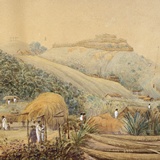 Pomare
Pomare
Pōmare II was a prominent Ngāpuhi chief who signed the Treaty of Waitangi. He was later arrested by the British on suspicion of treason but released on the intervention of Tāmati Wāka Nene.
Read more... -
Taonui, Aperahama
Aperahama Taonui, of the Te Popoto sub-tribe of Ngāpuhi, was a founding member of the Kotahitanga movement, which evolved into the Māori parliaments of the 1890s.
Read more... -
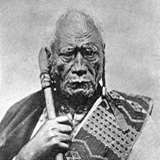 Taraia Ngakuti Te Tumuhuia
Taraia Ngakuti Te Tumuhuia
Ngāti Maru and Ngati Tamaterā chief who rejected the intrusion of Europeans in the traditional Māori world.
Read more... -
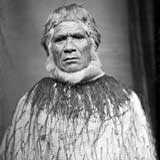 Te Hāpuku
Te Hāpuku
Hawke's Bay chief, Te Hāpuku, signed the 1835 Declaration of Independence and the Treaty of Waitangi. He opposed the King Movement fought against the Hauhau and Te Kooti.
Read more... -
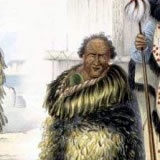 Te Heuheu Tūkino III, Iwikau
Te Heuheu Tūkino III, Iwikau
A paramount chief of Ngāti Tūwharetoa, Iwikau Te Heuheu was an ardent proponent of Māori nationalism, supporting the movement to set up a Māori king.
Read more... -
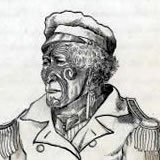 Te Rauparaha
Te Rauparaha
Te Rauparaha was a Ngāti Toa chief and warrior. Sometimes called the 'Napoleon of the Southern Hemisphere', he ruled the lower end of the North Island from his base at Kapiti Island for the best part of 20 years
Read more... -
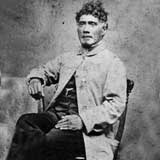 Te Whiwhi, Hēnare Mātene
Te Whiwhi, Hēnare Mātene
Hēnare Mātene Te Whiwhi promoted the idea of a Māori monarch, which he believed would be vital to protect Māori land.
Read more... -
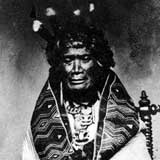 Te Rangitopeora
Te Rangitopeora
A signatory to the Treaty of Waitangi, Rangi Topeora was often referred to as the Queen of the South. She was a noted composer and mediator, and rejected European clothing throughout her life.
Read more... -
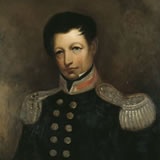 Hobson, William
Hobson, William
After a lengthy Royal Navy career in which he saw action in the Napoleonic Wars and was twice captured by pirates in the Caribbean, William Hobson (1792-1842) became New Zealand's first Governor.
Read more... -
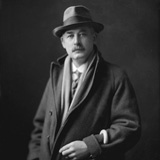 Buick, Thomas Lindsay
Buick, Thomas Lindsay
Politician, journalist and historian Thomas Buick produced a biography of Te Rauparaha before publishing his best known and most important book, The Treaty of Waitangi, in 1914
Read more... -
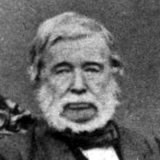 Bunbury, Thomas
Bunbury, Thomas
Biography of Thomas Bunbury gathered signatures for the Treaty of Waitangi in the South Island and Steward Island.
Read more... -
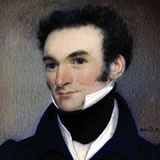 Busby, James
Busby, James
Edinburgh-born James Busby was British Resident, a consular representative, in New Zealand from 1833. Based at Waitangi in the Bay of Islands, he was given little material support to achieve British policy aims, but in early 1840 he helped William Hobson draft the Treaty of Waitangi.
Read more... -
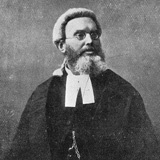 Prendergast, James
Prendergast, James
Lawyer James Prendergast was New Zealand's third chief justice.
Read more... -
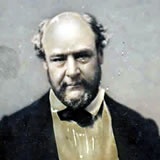 Spain, William
Spain, William
William Spain was a land commissioner who investigated the New Zealand Company's claims that it had purchased 20 million acres in 1839. The claims were not settled until several years after Spain's death
Read more... -
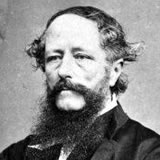 Colenso, William
Colenso, William
Colenso arrived at the Bay of Islands as the Church Mission printer in December 1834. His achievements include printing the New Testamont in Māori and the Māori version of the Treaty of Waitangi.
Read more... -
 Williams, Henry
Williams, Henry
Henry Williams was a missionary who supported British annexation. He believed that Māori should be protected from lawless Europeans and fraudulent dealings. He and his son Edward translated the Treaty of Waitangi into Māori.
Read more... -
 Te Kawau, Āpihai
Te Kawau, Āpihai
Te Kawau was a Ngāti Whātua leader who signed the Treaty of Waitangi at Manukau Harbour in March 1840. He later worked with European magistrates to settle disputes among Māori.
Read more...
Related keywords
- wellington city
- edward gibbon wakefield
- william wakefield
- basin reserve
- chinese
- moka te kainga-mataa
- ngapuhi
- waitangi
- aperahama taonui
- missionaries
- new zealand wars
- william williams
- riwha titokowaru
- queen elizabeth
- te atairangikaahu
- jim bolger
- tainui
- royalty
- waitangi day
- waitangi tribunal
- roadside stories
- te aitanga-a-mahaki
- riperata kahutia
- donald mclean
- stamps
- sesquicentenary
- william colenso
- thomas bunbury
- centennial
- exhibitions
- maori
- treaty signatories
- land claims
- Maori MPs
- MPs
- kotahitanga
- hone heke ngapua
- thomas buick
- historical writing
- te rauparaha
- gisborne
- maori land court
- tauranga
- ngati toa
- ngati raukawa
- wairau incident
- henare te whiwhi
- te reo māori
- william hobson
- edward shortland
- kororareka
- hone heke
- te ruki kawiti
- tamati waka nene
- new zealand company
- william spain
- maori leaders
- james busby
- declaration of independence
- charles de thierry
- coromandel town
- ngati tamatera
- tāraia ngākuti te tumuhuia
- james prendergast
- law
- law reform
- treaty claims
- ngai tahu
- douglas graham
- parliament
- ngati tuwharetoa
- iwikau te heuheu tukino iii
- kawhia
- manakau
- ngati maru
- ngati kahungunu
- te hapuku
- treaty house
- tahupotiki wiremu ratana
- te rangitopeora
- te rangihaeata
- nohorua
- cartoon
- apihai te kawau
- ngati whatua
- musket wars
- education
- james carroll
- apirana ngata
- māori health
- protest
- michael joseph savage
- bastion point
- links
- pre-1840 contact
- pomare II
- northern war
- conservation
- thomas hocken
- wiremu parata
- printing
- famous firsts
- henry williams
- pai marire
- kingitanga
- tukaroto potatau matutaera tawhiao
- land confiscation
- religion
- national identity
- royal tours
- race relations
- 1950s
- waikato
- maori land
- governor
- legislative council
- governor-general
- robert fitzroy
- george gipps
- british empire
- justice system
- francis fenton
- henry sewell
- rua kenana
- wiremu pomare
- timeline
- whina cooper
- urbanisation
- nga tamatoa
- hikoi
- elizabeth pulman
- photography
- waikato wars
- george grey
- bay of islands
- matiaha tiramorehu
- flags
- colonisation
- painting
- maps
- te kooti
- parihaka attack
- dominion of new zealand
- citizenship
- george clarke
- james stephen
- united tribes
- julius vogel
- reform party
- liberal party
- public holidays
- government
-
Main image: Moka Te Kainga-mataa
Image of Ngāpuhi leader and Treaty of Waitangi signatory , Moka Te Kainga-mataa

